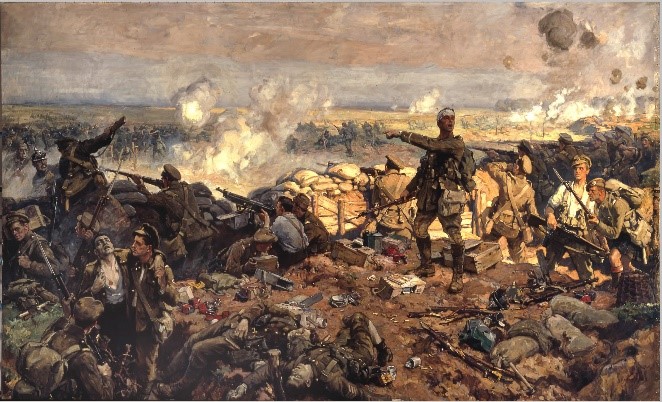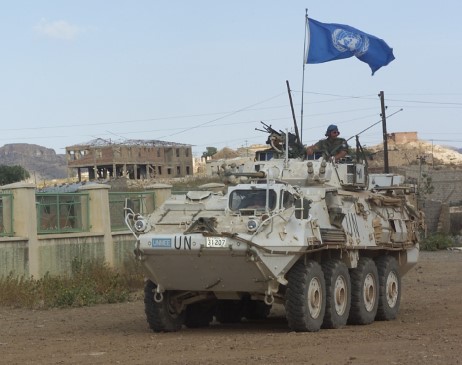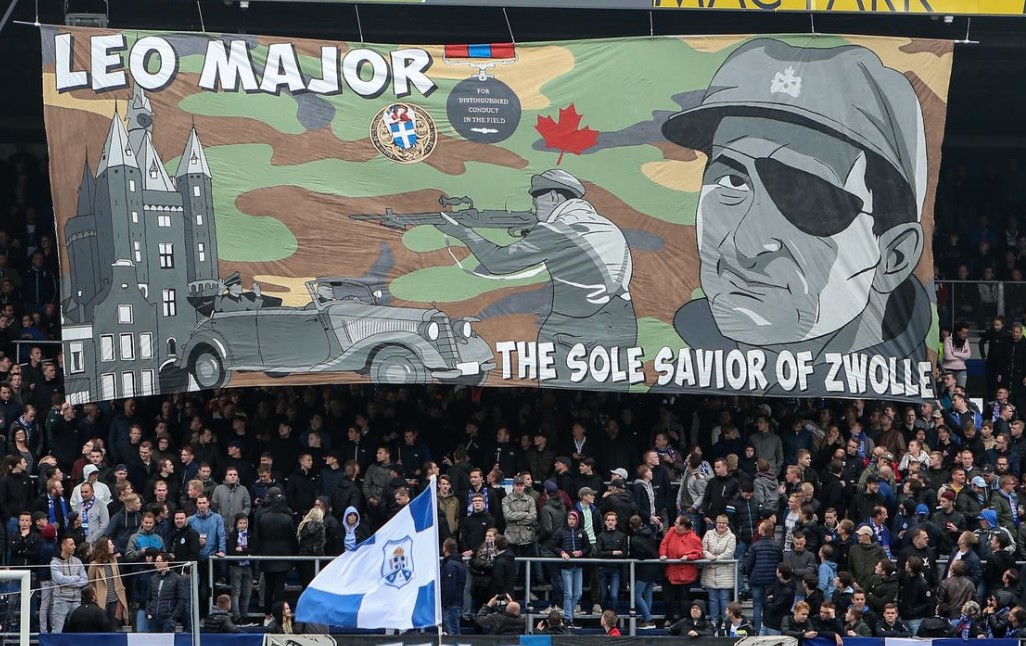Canada Remembers Times
Veterans’ Week Special Edition
5-11 November 2020 - Page 2
Fighting for breath
The Second Battle of Ypres, 22 April to 25 May 1915 painting by Richard Jack.
Image: 19710261-0161 Beaverbrook Collection of War Art. © CWM
It is hard for us today to imagine the horrors of fighting in the First World War. Heavy machine gun, rifle and artillery fire took a deadly toll on the soldiers in the trenches of the Western Front. But a terrible new weapon arrived on the battlefields on 22 April 1915 when the Germans released poison gas during the 2nd Battle of Ypres in Belgium.
The Allied troops beside the Canadian positions took the worst of the choking clouds of yellow-green chlorine and were forced to retreat. The Germans quickly charged forward and the Canadians fought all through the night and into the next day to close the large gap that had developed in the defensive lines. Our soldiers’ heroic actions gave the Allies time to recover and prevent a massive enemy breakthrough. On April 24, however, the Germans launched another gas attack—and this time the Canadians would be the primary targets. In a nightmare of fighting that saw the Canadians gasping for air through soaked and muddy handkerchiefs, they held on against all odds until Allied reinforcements arrived.
In their first major action of the war, our soldiers had begun building a remarkable reputation for skill and valour on the battlefield. It came at a steep cost, however, as more than 2,000 Canadians were killed and 4,000 wounded.
Canada in Ethiopia and Eritrea
Royal Canadian Regiment soldiers patrolling in Eritrea in February 2001.
Photo: Department of National Defence ISD01-0112a
Our country has a long and proud tradition of serving in international peace support efforts. Twenty years ago, Canadian Armed Forces members deployed to Ethiopia and Eritrea in the Horn of Africa to take part in a large United Nations (UN) mission.
Ethiopia and Eritrea had once been one country but Eritrea gained its independence in 1993 after a bloody civil war. However, border disputes again flared into open fighting in the late 1990s before a ceasefire was declared in 2000 and UN peacekeepers moved in. Some 450 Canadian Armed Forces members—including armoured reconnaissance, mechanized infantry, engineer and support elements—were part of the initial UN force. Canadian soldiers established checkpoints and patrol bases to help enforce the terms of the peace treaty before their six-month deployment came to an end.
Some Canadian officers also worked as UN Military Observers in the hot and dusty region until mid-2003, monitoring the security zone and helping arrange humanitarian aid for the local civilians. The Canadians who served in Ethiopia and Eritrea also often volunteered their personal time and resources to help the people there by rebuilding a damaged school and distributing clothes, school supplies, sports equipment and toys to children.
A Second World War love story
The happy couple celebrating their 70th wedding anniversary in 2016.
Photo: Courtesy of the Luscombe family
Vicky Goodyear and Bill Luscombe were both born in July 1925 in St. John’s, Newfoundland, and were cared for in the same hospital nursery.
They turned 18 during the Second World War and both joined the Canadian Army. Vicky became a driver in the Canadian Women’s Army Corps, serving as a courier in British Columbia. Meanwhile, Bill was bravely fighting in Europe and taking part in the Liberation of the Netherlands.
There was much celebration around the globe when the Second World War finally came to an end in 1945. Bill and Vicky could return home at last. Coincidentally, they both caught the same ferry to Newfoundland and met on board.
It had been years since the two were cared for in the same nursery, but love quickly blossomed. They married soon after and raised a family of five children in St. John’s—a true love story from the cradle to the waves!
Earlier this year, a vintage image of Vicky celebrating the end of the Second World War was featured on commemorative street banners in Ottawa.
A Major accomplishment
Léo Major banner at a soccer game in Zwolle.
Photo: Public domain
Léo Major was a true war hero. Many of his feats were impressive but what he did in the Dutch city of Zwolle during the Second World War tops it all.
In the spring of 1945, Canadian troops were pushing forward in the Netherlands. The German soldiers were weary, but the fighting often remained tough. On 13 April 1945, the Canadians were on the outskirts of Zwolle, a town of 50,000 people.
Major and his friend, Willy Arsenault, were sent to probe enemy defenses. They were spotted and came under fire. Arsenault was killed and an angry Major decided to change the plan. He pushed on and by luck found a German commander. Major explained that if their troops did not retreat, the Canadians would shell the historic town, killing many people. To convince the enemy, the clever Major then ran around Zwolle firing his weapons and throwing grenades, making it seem like the attack was underway. The Germans were fooled and pulled out, allowing the Canadians to enter Zwolle on April 14, without a fight. Thanks to Major’s outstanding bravery, the town and many lives had been saved.
Years have passed but Léo Major is still a legend in the Netherlands. He was made an honorary citizen of Zwolle in 2005 and recently, the local soccer club even put his name on their game jerseys to mark the 75th anniversary of the country’s liberation.
Studying at “Khaki University”
A Khaki University agriculture class visiting the Royal Farms at Windsor Castle in England.
Photo: Library and Archives Canada
Imagine being a young Canadian serving overseas during the First World War. Surviving the conflict and getting back home would likely be on your mind a lot.
Hundreds of thousands of Canadian service members had enlisted as teenagers, so returning home meant figuring out what they wanted to do with the rest of their lives. As the war neared its end, the Canadian Expeditionary Force established a special educational program to boost morale and give our soldiers skills that they could use in their civilian lives.
Formally established in 1917, it would become known as “Khaki University” (named after the colour of the fabric used for soldiers’ uniforms). A variety of instructional courses were offered—primarily at military camps in Britain—on subjects like agriculture, business, mechanics, law, health and teaching.
Thousands of illiterate men also learned how to read and write. For more advanced students looking to further their formal education, the certificates they earned there were also accepted by universities back in Canada. More than 50,000 Canadians would attend Khaki University before it closed in 1919 after the First World War had come to an end.
This dedication to helping Veterans with their education has endured. Khaki University again operated in Britain as the Second World War neared its end in 1945. And today, Veterans Affairs Canada offers support to a whole new era of service members pursuing further education after leaving the military.
Some Canadian military milestones

FIRST WORLD WAR 1914-1918
- 22 April 1915 - Canadians see first major action at Ypres
- 1 July 1916 -Start of the Battles of the Somme and Beaumont-Hamel
- 9 April 1917 - Start of the Battle of Vimy Ridge
- November 1917- Canadians capture Passchendaele
- 11 November 1918 - End of the First World War
SECOND WORLD WAR 1939-1945
- September 1939 - Start of the Battle of the Atlantic
- 25 December 1941 - Canadians in Hong Kong forced to surrender
- 19 August 1942 - Canadians take part in the Dieppe Raid
- June-August 1944 - Canadians fight in D-Day and the Battle of Normandy
- 5 May 1945 - Canadians liberate the Netherlands
- 8 May 1945 - Victory in Europe (V-E) Day
- 15 August 1945 - Victory over Japan (V-J) Day
- Date modified:




